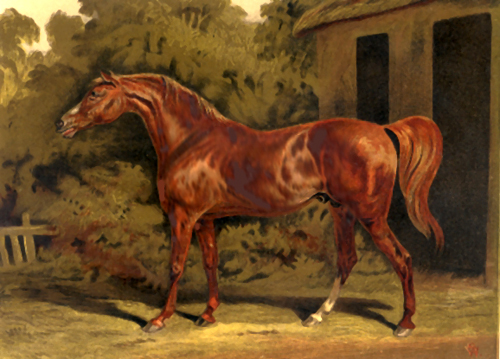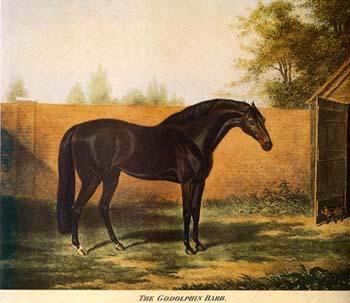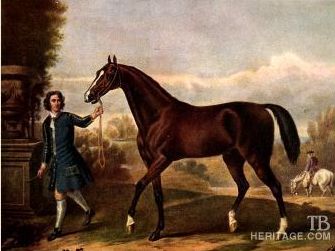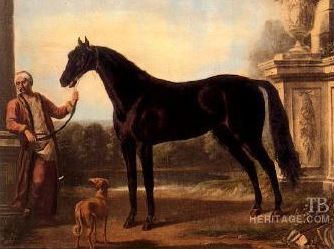
Eclipse, the stallion described as the greatest racehorse of all time, is to have his DNA studied by scientists.
The team, from the Royal Veterinary College and Cambridge University, hope to get an insight into what made him such a great champion.
Eclipse was never beaten when he ran in 1769 and 1770 and was retired largely because of the lack of competition.
It was his prowess on the track that gave rise to the famous phrase, "Eclipse first, the rest nowhere".
"He was the greatest in history and to get a look at his genetic material will be pretty amazing," said Professor Matthew Binns, a equine genetics expert from the RVC, who is part of the project.
"He won 18 races and usually by 10 or 20 furlongs. You have to remember that races were much longer in those days," he told the BBC News website.
Professor Binns and other equine researchers have been detailing their work at the British Association's Festival of Science, which this year is being held in Dublin, Ireland.
Narrow line
Eclipse is one of several "kings of the turf" from the more distant past who will have their "life codes" investigated. Others include the 1867 Derby winner, Hermit; and the late 19th Century stallion St Simon, who sired 10 horses that between them won 17 classic races.
Their remains and those of other horses in the project have been kept in collections and by museums. Eclipse himself had his whole skeleton preserved after his death, so important was he considered to our understanding of equine physiology.
But getting at the DNA will be a tricky business because the molecule degrades quickly over time. Scientists at Cambridge's McDonald Institute will have to use sensitive techniques recently developed to retrieve DNA from ancient human remains.
"Dr Mim Bower will lead this work," said Professor Binns. "Our preferred material is a tooth because the DNA is better protected but we'll also be tackling long bones and hooves.
"The Victorians were very keen on turning them into ink wells and candlesticks and there are some of these around from famous old horses."
The research will give insights into the origins of the world's thoroughbred racing stock. Research conducted at Trinity College Dublin has already shown that today's racehorses can trace their line to a very small group of animals imported from the Near East and North Africa in the early 1700s.
"The effective number of founders is only about 28," said Patrick Cunningham, a professor of animal genetics at Trinity. "They contribute pretty well all the genes seen in today's population, and the top 10 contribute about 80% of the genes."
Future champions
The RVC-Cambridge work will add further detail to this story and it should also show up which genetic traits have come through the 30 or so generations since the foundation of the stock.
One set of remains the project would dearly like to study are those of Godolphin Arabian. The horse, originally from the Yemen, was one of the founding 28 and it is buried in a country park in the Gog Magog hills just south-east of Cambridge.
Discussions are ongoing with the park's owners to see if the animal's skeleton can be exhumed so that samples can be taken.
Genetics is playing an ever bigger role in equine science as researchers try to understand what goes into making a great champion, and what makes other horses more susceptible to disease or more likely to break down in training.
"We're using new technologies called microarray, or gene-chip, technologies that have revolutionised biological science in the last five years," explained Dr Emmeline Hill, from University College Dublin.
"These are now being adapted for the horse and they allow us to look at thousands of genes in parallel, to understand gene expression and to look at molecular networks and interactions in muscle cells that are under pressure at the end of a race."
国立獣医大学とケンブリッジ大学の研究チームは、エクリプスを偉大なチャンピオンにしたものに関する洞察を得ようとしています。
エクリプスは1769〜1770年の競争において一度も負けることなく、ライバル不在を主な理由に引退した。
エクリプスの競技場での武勇を讃える有名な言葉があります。「エクリプスが速すぎて、後続がどこにもいない。」
「彼は歴史上最も偉大であり、彼の遺伝子に着目することはとても興味深いことだ。」(RVCの馬遺伝学専門家でありプロジェクトにも参加している)マシュー・ビンズ教授は言います。
「エクリプスは18勝しましたが、それは2000m〜4000mの距離でのことです。しかし、思い出して下さい。その当時、レースは距離がもっと長かった。」と彼はBBCに伝えました。
この年、アイルランドのダブリン(愛国首都)で開かれた英・学術協会で、ビンズ教授と他の馬研究者は研究の詳細を述べました。
細長い線
エクリプスは、どの馬にその「ライフ・コード」があるかを調査された、はるか大昔からの「芝生の王」の1頭である。他には、1867年のダービー馬”ハーミット”や19世紀後半の種牡馬”セント・サイモン”(10頭の産駒でクラシック・レースを17勝)が挙げられる。
プロジェクトにおける彼らの遺体や他の馬の遺体は、コレクションや博物館によって保たれていました。エクリプスは死後、自身の全体の遺骨を保存していました。馬の生理学への理解について考える上で、彼はとても重要な存在です。
しかし、分子は時間がたつにつれて急速に質が落ちるので、DNAに達するのはとても難しい仕事でしょう。 ケンブリッジ・マクドナルド研究所の科学者は、古代の人骨からDNAを検出するために最近開発された、繊細な技術を使用しなければならないでしょう。
「ミム・バウアー博士がこの仕事の最先端を行くでしょう。」と、ビンス教授は言いました。 「私たちにとって都合のよい材料は歯です。理由としては、DNAの保存状態が良いためです。また他にも、私たちは長骨と蹄にも取り組むでしょう。」
「ビクトリア人は”馬の骨”をインク入れや燭台に変えるのに非常に夢中でした。そして、そのうちのいくつかは過去の名馬から造られています。」
研究は、世界のサラブレッド血統の起源に洞察を与えるでしょう。ダブリンのトリニティー大学で行われた研究がすでに示したことは、以下の通り。現代の競走馬は、1700年代前半に近東や北部アフリカから持ち込まれた非常に小さいグループの動物にその足跡を辿ることができるということ。
「始祖の有効な数はおよそ28だけです。」と、パトリックカニンハム(トリニティ大学、動物遺伝学の教授)は言いました。 「彼らは、今日の個体群で見られるすべての遺伝子にかなりの貢献をしています。そして、最高の10頭は遺伝子のおよそ80%に貢献してします。」
将来のチャンピオン
RVC-ケンブリッジの研究はこの話に詳細を加えるでしょう。さらに、血統の創始以来、どの遺伝的特徴が30世代以上に受け継がれているかをはっきりとさせることでしょう。
プロジェクトが心底研究したがっている残りの1セットは、”ゴドルフィン・アラビアン”のものです。イエメンで生まれたこの馬は、始祖28頭の内の1頭でした。そして、ケンブリッジ南東のゴグ・メーゴグの地方公園に埋葬されました。
動物(ゴドルフィン)の遺骨を発掘し、サンプルを取ることについては、公園の所有者と討議中です。
偉大なチャンピオンを作るため何が必要か、何が馬を病気に感染させるのか、トレーニングで故障を発生させるものは何か、等を理解しようとするとき、遺伝学は馬の科学により大きな役割を果たしています。
「我々はここ5年間で生命科学を変革した技術である、マイクロアレイ、またはDNAチップと呼ばれる新技術を使用しています。」と、ダブリン大学のエメライン・ヒル博士は説明しました。
「これらの技術は現在、馬に適合させられていて、何千もの遺伝子を平行線上に見ることができ、遺伝子発現を理解して、レース後の負荷を受けた状態における筋肉細胞の分子ネットワークと相互作用を調べさせるものです。」


